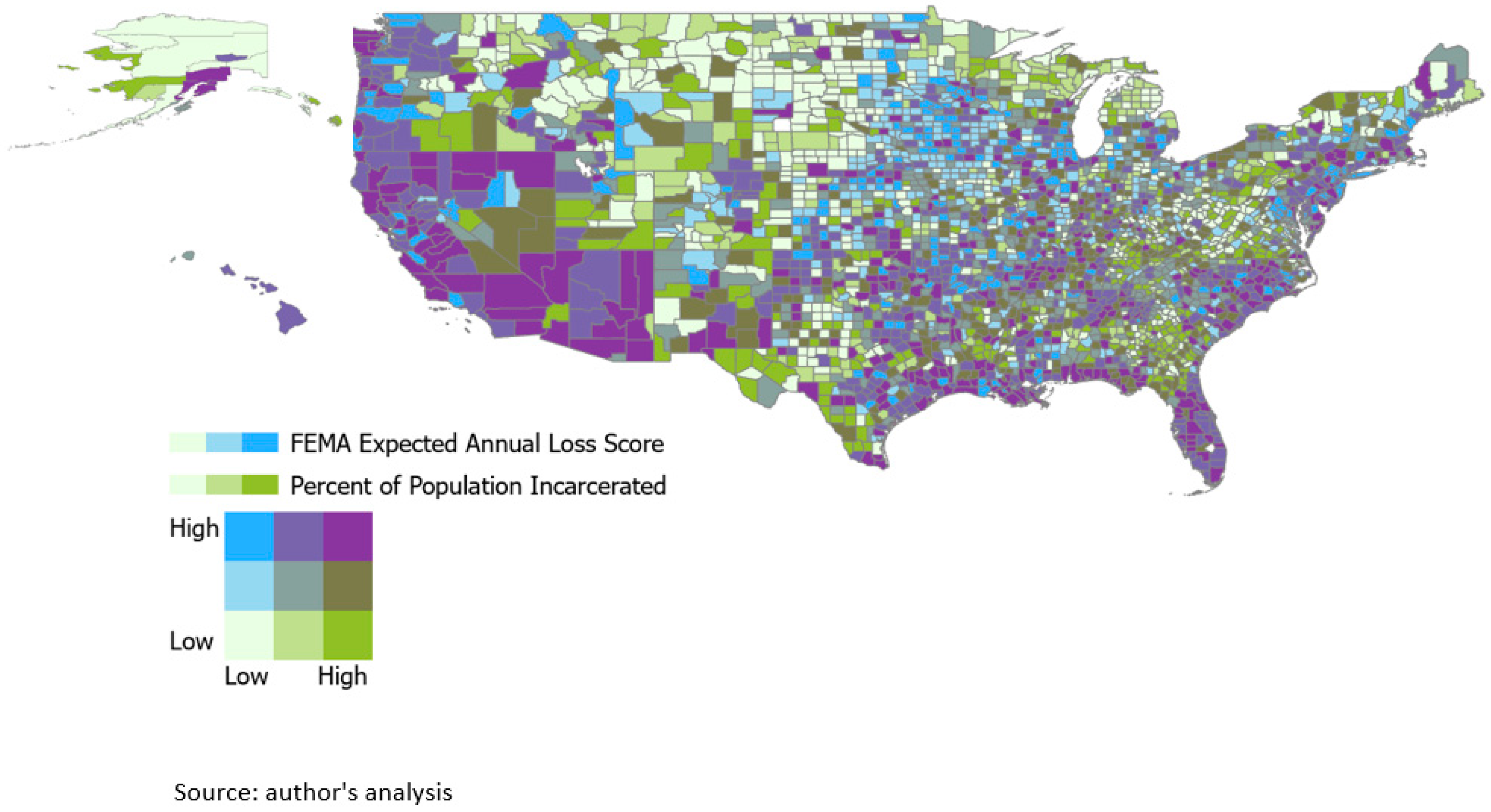Overlapping Crises: Climate Disaster Susceptibility and Incarceration
Abstract
:1. Introduction
2. Methods
2.1. Data Sources
2.2. Spatial Methods
3. Results
4. Discussion
5. Public Health Implications
Author Contributions
Funding
Institutional Review Board Statement
Data Availability Statement
Conflicts of Interest
References
- Intergovernmental Panel on Climate Change. Climate Change 2021 the Physical Science Basics. 2021. Available online: https://www.ipcc.ch/report/ar6/wg1/downloads/report/IPCC_AR6_WGI_Full_Report.pdf (accessed on 6 June 2022).
- Trust for American’s Health. Climate Change and Health: Assessing State Preparedness. 2021. Available online: https://www.tfah.org/report-details/climate-change-health-assessing-state-preparedness/ (accessed on 6 June 2022).
- Benevolenza, M.A.; DeRigne, L. The impact of climate change and natural disasters on vulnerable populations: A systematic review of literature. J. Hum. Behav. Soc. Environ. 2019, 29, 266–281. [Google Scholar] [CrossRef]
- Fatemi, F.; Ardalan, A.; Aguirre, B.; Mansouri, N.; Mohammadfam, I. Social vulnerability indicators in disasters: Findings from a systematic review. Int. J. Disaster. Risk Reduct. 2017, 22, 219–227. [Google Scholar] [CrossRef]
- Golembeski, C.; Armstrong, A.; Irfan, A.; Méndez, M.; Shaprio, N. “Climate Change and Incarceration,” ThinkGlobalHealth. 2022. Available online: https:////www.thinkglobalhealth.org (accessed on 6 June 2022).
- Prins, S.J.; Story, B. Connecting the Dots Between Mass Incarceration, Health Inequity, and Climate Change. Am. J. Public Health 2020, 110, S35–S36. [Google Scholar] [CrossRef] [PubMed]
- Browning, C.R.; Wallace, D.; Feinberg, S.L.; Cagney, K.A. Neighborhood Social Processes, Physical Conditions, and Disaster-Related Mortality: The Case of the 1995 Chicago Heat Wave. Am. Sociol. Rev. 2006, 71, 661–678. [Google Scholar] [CrossRef] [Green Version]
- Moise, I.K.; Ruiz, M.O. Hospitalizations for Substance Abuse Disorders Before and After Hurricane Katrina: Spatial Clustering and Area-Level Predictors, New Orleans, 2004 and 2008. Prev. Chronic Dis. 2016, 13, E145. [Google Scholar] [CrossRef] [PubMed] [Green Version]
- Aldrich, D.P.; Meyer, M.A. Social Capital and Community Resilience. Am. Behav. Sci. 2014, 59, 254–269. [Google Scholar] [CrossRef]
- Delilah Roque, A.; Pijawka, D.; Wutich, A. The Role of Social Capital in Resiliency: Disaster Recovery in Puerto Rico. Risk Hazards Cris. Public Policy 2020, 11, 204–235. [Google Scholar] [CrossRef]
- Agency for Toxic Substances and Disease Registry (ATSDR). CDC Social Vulnerability Index. Published 2020. Available online: https://www.atsdr.cdc.gov/placeandhealth/svi/index.html (accessed on 6 June 2022).
- Tate, E.; Rahman, M.A.; Emrich, C.T.; Sampson, C.C. Flood exposure and social vulnerability in the United States. Nat. Hazards 2021, 106, 435–457. [Google Scholar] [CrossRef]
- Eason, J. Mapping prison proliferation: Region, rurality, race and disadvantage in prison placement. Soc. Sci. Res. 2010, 39, 1015–1028. [Google Scholar] [CrossRef]
- Purdum, C.; Henry, F.; Rucker, S.; Williams, D.A.; Thomas, R.; Dixon, B.; Jacobs, F. No Justice, No Resilience: Prison Abolition As Disaster Mitigation in an Era of Climate Change. Environ. Justice 2021, 14, 418–425. [Google Scholar] [CrossRef]
- Ashby, H.; Vazin, J.; Pellow, D. Superfund Sites and Juvenile Detention: Proximity Analysis in the Western United States. Environ. Justice 2020, 13, 65–74. [Google Scholar] [CrossRef]
- FEMA. Expected Annual Loss. Available online: https://hazards.fema.gov/nri/expected-annual-loss (accessed on 3 August 2021).
- The Marshall Project, “About Us,” The Marshall Project. Available online: https://www.themarshallproject.org/about (accessed on 6 June 2022).
- The Marshall Project. Adults in Correctional Facilities, from Decennial Census (2000 to 2020). Published 2021. Available online: https://observablehq.com/@themarshallproject/adults-in-correctional-facilities-from-decennial-census (accessed on 2 July 2021).
- Getis, A.; Ord, J.K. The Analysis of Spatial Association by Use of Distance Statistics BT-Perspectives on Spatial Data Analysis; Anselin, L., Rey, S.J., Eds.; Springer: Berlin/Heidelberg, Germany, 2010; pp. 127–145. [Google Scholar] [CrossRef]
- Esri Inc. ArcGIS Pro, Version 2.8.3; Esri: Chicago, IL, USA, 2022.
- American Public Health Association. Advancing Public Health Interventions to Address the Harms of the Carceral System. Am. Public Health Assoc. Published online 2020. Available online: https://www.apha.org/policies-and-advocacy/public-health-policy-statements/policy-database/2021/01/14/advancing-public-health-interventions-to-address-the-harms-of-the-carceral-system (accessed on 6 June 2022).
- National Prison Project of the American Civil Liberties Union. Abandoned and abused: Prisoners in the wake of Hurricane Katrina. Race Cl. 2007, 49, 81–92. [Google Scholar] [CrossRef]
- Wildeman, C.; Wang, E.A. Mass incarceration, public health, and widening inequality in the USA. Lancet 2017, 389, 1464–1474. [Google Scholar] [CrossRef]
- Motanya, N.C.; Valera, P. Climate Change and Its Impact on the Incarcerated Population: A Descriptive Review. Soc. Work Public Health 2016, 31, 348–357. [Google Scholar] [CrossRef] [PubMed]
- Hamblett, A.; LeMasters, K.; Cowell, M.; Maner, M. To Better Address COVID-19 Among Incarcerated People, More Collaboration Is Needed Between State Departments Of Health And Departments Of Corrections. Health Aff. Forefr. Published online 2022. Available online: https://www.healthaffairs.org/do/10.1377/forefront.20220127.35520/ (accessed on 6 June 2022).
- Hatzenbuehler, M.L.; Keyes, K.; Hamilton, A.; Uddin, M.; Galea, S. The Collateral Damage of Mass Incarceration: Risk of Psychiatric Morbidity Among Nonincarcerated Residents of High-Incarceration Neighborhoods. Am. J. Public Health. 2014, 105, 138–143. [Google Scholar] [CrossRef]
- Liu, H.; Li, T.W.; Liang, L.; Hou, W.K. Trauma exposure and mental health of prisoners and ex-prisoners: A systematic review and meta-analysis. Clin. Psychol. Rev. 2021, 89, 102069. [Google Scholar] [CrossRef]

Publisher’s Note: MDPI stays neutral with regard to jurisdictional claims in published maps and institutional affiliations. |
© 2022 by the authors. Licensee MDPI, Basel, Switzerland. This article is an open access article distributed under the terms and conditions of the Creative Commons Attribution (CC BY) license (https://creativecommons.org/licenses/by/4.0/).
Share and Cite
Cowan, K.N.; Peterson, M.; LeMasters, K.; Brinkley-Rubinstein, L. Overlapping Crises: Climate Disaster Susceptibility and Incarceration. Int. J. Environ. Res. Public Health 2022, 19, 7431. https://doi.org/10.3390/ijerph19127431
Cowan KN, Peterson M, LeMasters K, Brinkley-Rubinstein L. Overlapping Crises: Climate Disaster Susceptibility and Incarceration. International Journal of Environmental Research and Public Health. 2022; 19(12):7431. https://doi.org/10.3390/ijerph19127431
Chicago/Turabian StyleCowan, Kristen N., Meghan Peterson, Katherine LeMasters, and Lauren Brinkley-Rubinstein. 2022. "Overlapping Crises: Climate Disaster Susceptibility and Incarceration" International Journal of Environmental Research and Public Health 19, no. 12: 7431. https://doi.org/10.3390/ijerph19127431
APA StyleCowan, K. N., Peterson, M., LeMasters, K., & Brinkley-Rubinstein, L. (2022). Overlapping Crises: Climate Disaster Susceptibility and Incarceration. International Journal of Environmental Research and Public Health, 19(12), 7431. https://doi.org/10.3390/ijerph19127431





